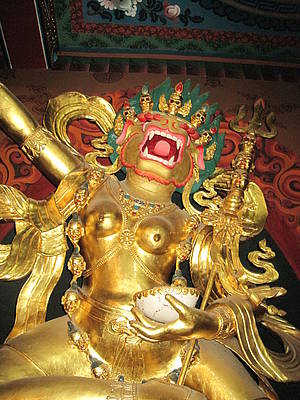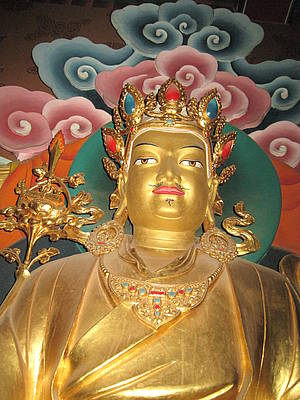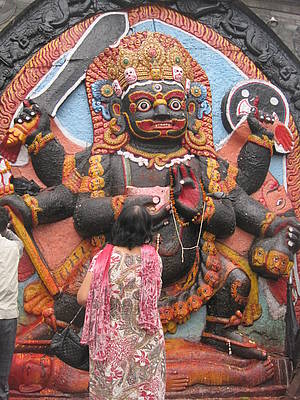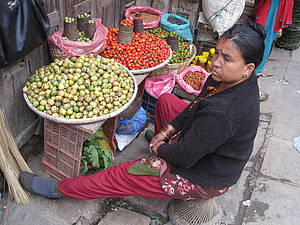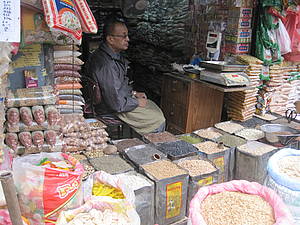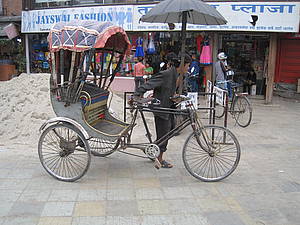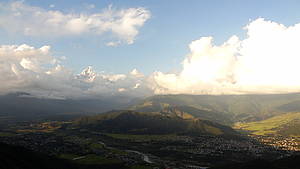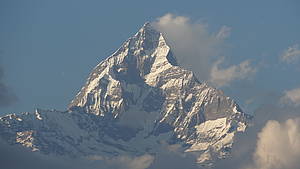Nepal 2014
Holiday in Nepal – 10th October – 22nd October 2014
As usual, I would like to start my travel report with some historical facts. I have chosen some events from Nepal history, which have connection with our travel and experience.
- One hundred thousand years BC, a huge lake filling the valley was drained away and Kathmandu Valley was formed. This geological fact is described also in a local legend: the God Manjushree saw a lotus flower in the center of the lake, took his sword and cut a gorge at Chovar to allow the lake to drain. The place where the lotus flower settled became Swayambhunath Stupa and the valley became habitable.
- Siddhartha Gautama, the Buddha, was born in Lumbini in southern Nepal cca 563 BC
- 11th century - the Samvarodaya Tantra, the first known text recording Buddhist tantric worship of Kumari, is composed in Nepal
- End of 14th century – Jaya Stithi Malla unites the Valley and codifies its laws. After his death the Valley is split between his six sons into three rival Malla kingdoms of Kathmandu, Patan and Bhaktapur
- 1491 – the joint kings of Bhaktapur establish the first royal Kumari.
- The dynasty of Mallas lasts till 1768, when Prithvi Narayan Shah, king of Gorkha, storms Kathmandu during the festival of Indra Jatra (procession in honor of Kumari) and forces the king Jay Prakasha Malla to flee. He also attacks Bhaktabpur and captures all three Malla kings. Then he moves his capital from Gorkha to Kathmandu where he establishes the Shah dynasty – which remained on the throne until 2008.
- Nepal has never been a colony. However, the country lost two year lasting Anglo-Nepali war and the Treaty of Sugauli signed in 1816 established Nepal´s modern boundaries (one third of territory, especially Terai and Sikkim remained with the British – now with India) and it also gave Britain the right to recruit Gorkha soldiers in Nepal and maintain a residency in Kathmandu.
- In 1846 the Kot Massacre eradicated the cream of the court aristocracy, ushering in the Rana era. From 1846 until 1951, the country was de facto ruled by the hereditary prime ministers from the Rana dynasty, reducing the Shah Kings to puppets.
- In 1951, king Tribhuvan and the Nepal Congress Party with Indian support overthrew the Rana regime and opened the door to the outside world.
- Mount Everest, the highest mountain of Nepal and of the world (8848 meters), was conquered in 1952 by Edmund Hillary and Tibetan Sherpa Tenzing Norgay.
- In 1975, Birendra was crowned king in Kathmandu´s Hanuman Dhoka. In1990, he was forced by the People´s Movement Jana Andolan to accept a new constitution, restoring democracy and changing the country into constitutional Hindu monarchy. (the only one in the world).
- A decade long Maoist fight for removal of monarchy and establishing “People´s Republic” resulted in the civil war which cost lives of 13 000 Nepalese (1996 – 2005).
- In 2001, the successor to the throne, the eldest son of the royal family prince Dipendra massacred 10 family members, including his father king Birendra and his mother and then shot himself. Birendra´s brother Gyanendra inherited the throne. There are various speculations about the reasons of this massacre which is difficult to understand. It happened in Dipendra´s house and it is said that he was drunk and drugged – therefore one of his brothers took him to his bedroom to sleep it out and not to upset their father he was supposed to appear at the gathering as per protocol as the last one. Suddenly Dipendra appeared back heavily armed and with the mask on his face, he shot his father first and then continued shooting around. Some versions talk about conspiracy supported by China, or India, or CIA, or Maoists etc. But if the question who profited from this massacre is asked, the more probable would be the version of the murders being organized by king´s brother Gyanendra. He was the only one who without any obvious reason did not participate in the family meeting and went for trekking to Pokhara. His wife was present but not seriously harmed. He might have dreamed of becoming a king again, as he was already temporarily on the throne as a 3 years old boy when the enemies wanted to get rid of Birendra. Of course, there always remains the version that Dipendra might have been one of the amok runners (one version also said that he was not allowed to marry a girl with whom he was in love and therefore he took his revenge, but this one was not repeated by other sources, and does not seem very probable).
- In 2006, hundreds of thousands of people forced King Gyanendra to reinstate Parliament which voted for curtailing his emergency powers. Maoists and government officials signed a peace agreement and the Maoist rebels entered an interim government.
- In 2008 Nepal abolished the monarchy and became a federal democratic republic.
- 2014 - However, even now, Nepal is facing a great instability. 25 political parties are fighting for power and have a limited influence. The fulfillment of the promise that the Parliament formed as a result of the general elections, will give the country a new constitution, have been constantly postponed. The population starts to lose confidence in their political elites and is also deeply frustrated by the economic difficulties. The last deadline for passing the constitution which could stop the threatening crisis is the end of 2014. The country´s aim is to overcome dependence on agriculture and tourism and start using the main source of electrical energy which are its rivers. It would be possible to built hydro power stations for supplying power not only to the local population (the load sharing in Kathmandu is up to 8 hours a day, every hotel has to have a generator and many villages in Nepal do not have electricity connection at all), but also to export it to the neighbor countries which have a lack of electricity as well (China, India). The good news is that Nepal tries to enable school attendance to the maximum number of children also from the remote areas and that they start learning English in the first class. We saw many of these children in school uniforms walking or going on their bicycles to school every morning.
Diary
12th October
Early morning flight Goa – Mumbai – Kathmandu with Jet Airways – upgraded to business class on both parts of the flight – transfer from domestic airport to international airport in Mumbai easy and without problems
Arrival Kathmandu. Accommodation in hotel Hyatt, in the evening folkloric dinner – we made a bet with George if the girls will be dancing with jugs (as it happens in all these performances round the world which tend to be a tourist trap) – George was convinced that the jugs would come but they did not, so he lost the bet. The performance and the dinner were mediocre – the only specialty were pieces of grilled wild boar meat.
13th October
Visit to Durbar Square, Unesco World Heritage site, which consists of a cluster of temples around the Palace complex. These approximately 15 buildings concentrated in one area (temples and palaces) are well kept and very beautiful. Pashupatinath Temple which houses the sacred linga, phalic symbol, of Lord Shiva, and the Palace of living Goddess Kumari are the most interesting buildings. Kneeling figure of monkey God Hanuman as a guardian of the temple is placed on a stone pedestal with covered eyes. The reason? The neighbouring temple is richly carved and some of the carvings show erotic motives. Hanuman is a hermit, so he is supposed to be shy (explanation of our guide).
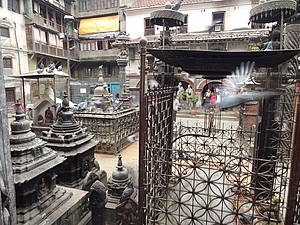
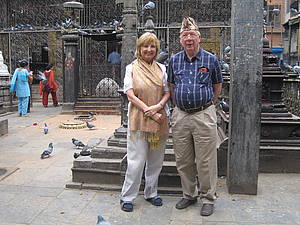
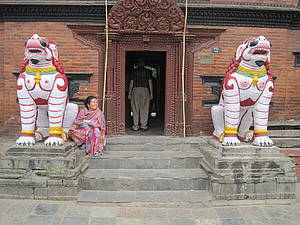
Kumari
I have been fascinated by the tradition of living goddess, Kumari, so I have collected some information which became available during our travel which might be of interest to everybody.
Kumari is a girl at the age between 3 – 12 years who is supposed to be incarnation of the goddess Durga/Taleju and worshipped by most Nepalese including the king who comes once a year, during the festival of Indra Jatra to get a blessing in the form of tika on his forehead.
Our guide told us that traditionally, the girls were selected from Shakya/Newar family according to strict criteria: In a wider selection the girl had to be perfect, no marks or blemishes on her body, not even the smallest scar or small pocks vaccination (which is properly physically checked), she had to have black hair, mild eyes of cow…(not an insult in Nepal  ). In the second stage the girls were closed in a room with the animals which were previously slaughtered as a sacrifice to gods (this tradition is still alive and permitted in Nepal – on the main festivity 120 bulls and 120 sheep are sacrificed to Durga in Kathmandu). The guardians make strange noises outside the house (howling of ghosts??) and the girl who does not show any signs of fear is selected.
). In the second stage the girls were closed in a room with the animals which were previously slaughtered as a sacrifice to gods (this tradition is still alive and permitted in Nepal – on the main festivity 120 bulls and 120 sheep are sacrificed to Durga in Kathmandu). The guardians make strange noises outside the house (howling of ghosts??) and the girl who does not show any signs of fear is selected.
Another source explained the selection process in detail as follows: The four or five year old little Shakya girl is chosen every ten years. The girl who is to be made Royal Kumari must possess several qualities. She must be free from any disfigurement. She must be a virgin with an unblemished body. She must have prominent black eyes or gorgeous expressive eyes, white teeth without any gaps. She must have a sonorous voice, long slender arms, delicate and soft hands and feet and straight hair curled towards the right side. Above all, she should possess 32 noble virtues. (I was not able to find out what virtues they must be in four years old child J). She must have a sense of courage and should not fear a masked man or an animal sacrifice. Her horoscope must match that of the king.
However, recently some former Kumaris denied that they had to be present at the scary rituals of sacrificing animals or that they would be closed with the dead animals during the selection process (maybe the times are changing).
When chosen, Kumari is separated from her parents and gets guardians who take care of her during the time of her assignment. She is not allowed to leave the premises, although recently more care is given to her in-house education. Only in the time of festivities, she is carried on the decorated charriot in the streets meeting worshipping crowds (which must be a sort of entertainment for the girl otherwise sitting at home). The house of Kumari, Kumari-Ghar, is a three storeyed quadrangle lavishly decorated with fine woodcarving. In the third storey there are 3 decorated windows – our guide had called aloud to Kumari´s guardians and so we were lucky to see her. The girl appeared in the middle window – her guardians in the windows besides her. When she appears everybody is supposed to bow and the visitors are supposed to give some contribution into the box for the maintainace of the house. The present Kumari is 8 years old but she looked older, probably because of the heavy make up. She was dressed up in a decorative red robe (she is allowed to wear only red or pink dresses) and did not smile. Once the girl reaches the puberty she has to abandon the house and is substituted by a new Kumari. She gets a rent from the Nepalease state for 10 years to enable her to finish her studies and continue her life. She is allowed to marry, but there is a superstition that the man who would marry her would die within a year. However, many former Kumaries got married and the husbands survived. 
There are several verses in the Vedas which eloquently glorify the position of Kumaris and their role in various spheres of life. As a female deity, she possesses Shakti (Power). Both benevolent and fearful she is worshipped as Kali, Durga and Taleju. However, Kumari as a female deity is also worshipped as the living virgin goddess, the defender of the living beings. The whole concept of Kumari as a living goddess originated when Tantricism reached its height in the Kathmandu Valley. The Bajracharya and Shakya clans played a crucial role and so the tradition of requiring the Kumari to come from the Shakya clan was established. (The most famous Shakya being the prince Siddhartha Shakya, the founder of Buddhism in the 5thcentrury BCE, who became known as Gautama Buddha).
There are two versions of an ancient story about origins of Kumari worship based on mythology. The Malla Kings of the Valley in ancient times had wide knowledge of practising Tantricism. They used to play dice and other games with the goddess Taleju with their tantric powers. King Jaya Prakash Malla, the last Malla ruler of Kathmandu, also used to play dice with Goddess Taleju. He became fascinated by the charming beauty of the goddess, he lost control and caught her by the hands. The goddess perceived his erotic thoughts, was enraged by his immoral attitude and immediately vanished from the king's sight. That night the king again saw Goddess Taleju in his dream. She strictly warned him that he shall no longer be blessed by her, his dynasty was going to an end. The king would only be able to get darshan in the new form of pre-menstrual girl belonging to the Shakya caste in whom the goddess herself will dwell as goddess Kumari. Since then, the Kumari is worshipped as the living virgin goddess.
The other version says that the game of throwing dice between the King and Goddess Taleju was interrupted in the middle of the night by a jealous queen who suspected that the King instead of discussing matters of state is entertaining a beautiful woman. The goddess was extremely hurt, drew herself up and spread her ten arms like wings. From her hips hung a belt of severed male heads and she was surrounded by an aura of flame. Three more lovely but frightening faces had appeared and she declared that she would not put up with such human frailties as jealousy and that the King would not see her any more. As in the previous version, in the end she took mercy on the King and recommended him to worship her in a form of an innocent girl – Kumari.
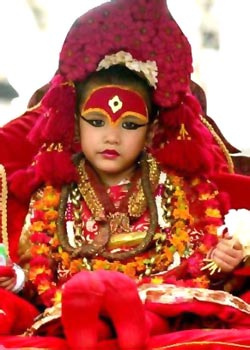
Jaya Prakash Malla built the house for Kumari, Kumari bahal, in 1767. He also instituted the festival of drawing the chariot of Kumari, the living goddess, followed by other two living gods- Ganesh and Bhairav.
Research book about Kumari – The Living Goddess by Isabella Tree.
Isabella Tree´s parents were among the first tourists to visit Nepal when the borders were opened in the 1950s. Their stories and her father´s pen and ink drawings covering the walls of the flat in London filled her with longings to see one day the stupas and pagoda temples of the Kathmandu Valley and the legendary child goddess.
In 1983 Isabella and her 3 school friends rented a flat in Freak Street, Kathmandu, in their gap year, just yards away from the Living Goddess´s house. This street is until now known as hippie street.
In 1997 she was invited by her friend Cheryl who married a colonel of the British Gurkhas to stay with them in Kathmandu and got acquainted with Cheryl´s Nepali teacher, who also introduced her to the ex-Kumari Rashmila Shakya (the author of the book From Goddess to Mortal).
The idea for a book about Kumari came in 2001 after the massacre of the Nepali royal family. With the country suddenly in turmoil, Isabelle finally found the openings to take her investigations further. Faced with uncertainty and the real threat of a Maoist takeover as well as a mounting attacks from anti-monarchists and human rights activists, the traditional guardians of the Living Goddess tradition were beginning to feel that the continued secrecy could be their downfall. If they did not attempt to show the world the value, at least, of the esoteric knowledge they had been protecting for centuries, this wisdom could be in danger of disappearing altogether. It was one of the reasons why suddenly Isabelle succeeded in meeting all ex Kumaries (not only the Royal Kumari of Kathmandu, but also the “local” Kumaris of Patan, Bhaktapur and other small places.).
She was able to combine historical facts (from the beginning of the tradition up to 2008), legends connected with Kumari and results of her own research very skilfully.
Experience book about Kumari - From Goddess to Mortal by Rashmila Shakya
Rashmila was Kumari herself (1984 – 1991) and writes about her own experience trying to put right some myths, half truths and lies connected with Kumari´s cult. She also describes the difficulties which adolescent girl had to face when her life as goddess was finished and she had to accommodate to the normal life among her brothers and sisters.
Position of the girls in the Nepalese society
Our guide told us also about other traditions in Nepal which applied to the Newar girls. Between 5 – 10 years of age, a girl is symbolically married for the first time to the God of Beal fruit. (Bael is a type of fruit which is considered sacred by Hindus. In Latin aegle marmelos. It reminds pear by shape but it looks like pomme granate inside). When the girl reaches the puberty, she is again symbolically married, this time to the God of Sun. Only the third marriage is to a human being, to a man. It is a sort of protection of girls against the Indian custom of satí (widows had to jump into the fire and were burnt with their husbands). Although satí was prohibitied in Nepal already in 1920, a certain stigma of being a widow remained (see the Indian movie Water). In Nepal, as a matter of fact, when the husband dies, the woman does not become a widow, because she remains married to a god. Our guide proudly showed us pictures of his daugther when the family was celebrating her first „wedding“.
Women and girls in Kathmandu and other cities look independent enough. However, especially in the remoted agriculture areas they are still considered to be inferior to men. This theory is supported by some old customs – e.g. bleeding is considered in some parts of the country as impure, therefore the girl who has her period is locked for 3 upto 7 days in a cow shed, no man (not even her husband) is allowed to touch her.
Continuation of sightseeing
In the afternoon we visited Boudhanath Stupa, one of the the world´s largest stupas at 36 meters high. We went around it in clock direction, admired the architecture and the third eye watching us and artistic production sold in the surrounding shops.
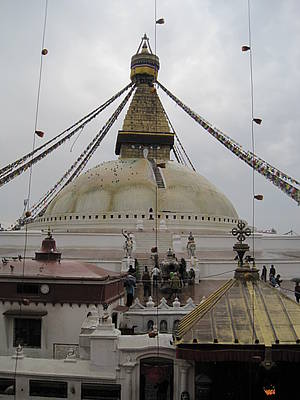
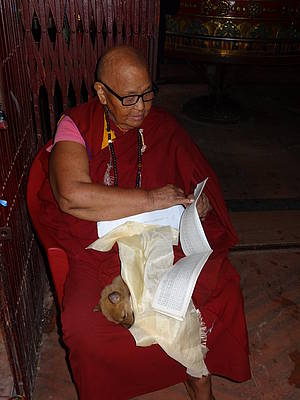
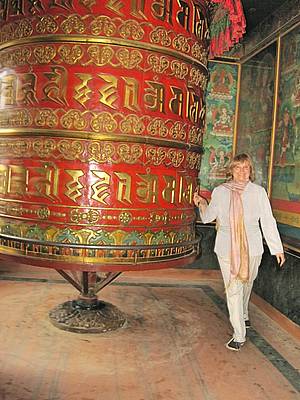
14th October
Pashupatinah Temple Kathmandu – the most holy place where the Nepalese wish to be cremated. When the king Bitendra and his family were massacred, the procession of many followers accompanied them on their last trip to the Pashupatinah Temple (as per tradition, the dead bodies are not hidden in the coffins. So the mutilated face of the queen was made from porcelain to keep the piety). There are cremation platforms to be seen, the ashes of the burnt bodies are strayed into the river. Next to the temple there is a hospital/hospice for seriously ill – they either heal or die happily in this auspicous place. Holy men sadhus begging for alms are walking around, many naughty monkeys jumping from the stone to stone. Pashupatinah Temple is a famous place for Hindus all over the world, it was visited recently also by the new Indian prime minister Narendra Modi.
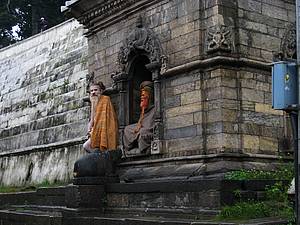
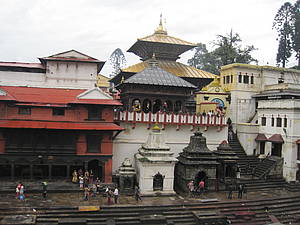
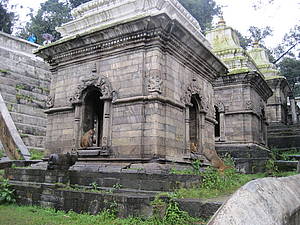
Nepal (not only Katmandu) was unexpectedly hit by heavy rain. In spite o fit, we continued to Bhaktapur, the cultural city of Nepal, one of the three of the valley capitals. It was founded in the 8th century, and used to be a capital from 12th to 15th century. It is situated at 1400 m over the sea level and belongs to Unesco World heritage. It is a fascinating place in the same way as the historic centre of Kathmandu, a living museum of Newari culture. We have bought an iron frog to sit at the side of our swimming pool there. 
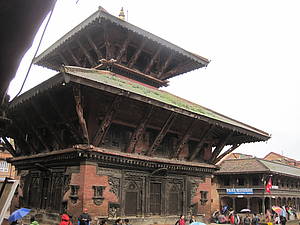
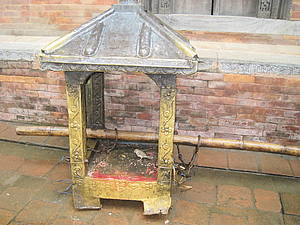
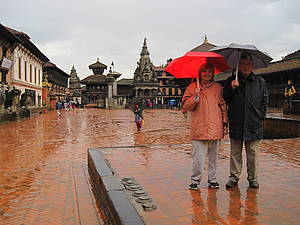
It continued to pour down until we reached our destination, mountain town Dhulikhel, hill resort Dwarika (1440 meters high). There were not many guests as it was still raining so we were upgraded into a beautiful house with a living room, bedroom, covered terrace with a swing and free terrace on the roof, everything built and furnished in natural materials (bathroom and toilet had a floor made from real pebbles - not pebble tiles  - and stones).
- and stones).
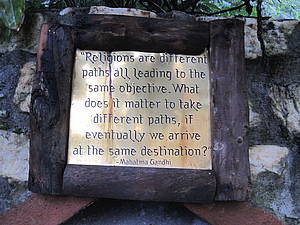
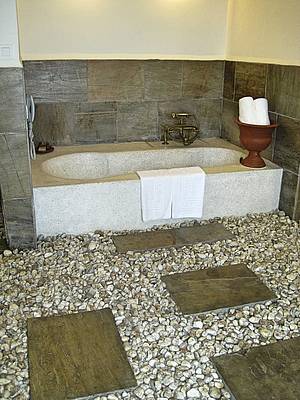

In the evening we were taken on the steep steps up the hill (around half an hour walk in the pouring rain) to a meditation centre for our first meditation lesson (neither George nor me have done it before – it was based on the breathing techniques). I have to say that the combination of being taken up the hill in the darkness, through amazing nature, climbing the steps, meeting a young man (he said that he obtained his master degree on Nietzsche and now was preparing his doctor thesis on meditation), sitting in a empty hall with him (nobody else was present), made quite an impression on me. Later on we went back down the hill to the restaurant where we could enjoy the culinary delights and also meet the owner of this hill station, a Nepalese lady who built this little paradise.
15th October
Departure from Dhulikel direction Bandipur. The weather improved and we could observe the beautiful mountains in the background (5 hours drive). In some parts the road was very bad with many potholes, but we had no real choice - it was supposed to be the national highway leading from the east to the west. Anyway, George was of the opinion, that the roads were not so bad after all - it must also have cost a fortune to build and maintain them and Nepal is no rich country.
We could see no real slums in Nepal – we passed many small villages or huts which of course offered only the basics, but the farmers, who work very hard – especially on the numerous rice fields - are able to keep their traditional way of life, and if the weather is good, they can feed their families - they looked satisfied. (of course I am aware of the well known fact that poverty in the country never looks so bad as the poverty in the city slums, but might sometimes be exactly as hard and paralyzing). Nepal has only 26 million population and although the concentration in a couple of cities (Kathmandu, Lalitpur, Phokara) is high, it cannot be compared with India. The agriculture is still prevailing.
When we reached Bandipur, we could immediately see that the place could not be called a town, it is a bigger village which accomodates back packers before their trekking tours into the mountains. We booked the best so called „heritage room“ in the best local hotel called Old Inn (when booking we had to fight for this room, as the other type had common toilets and bathrooms on the corridor, ours was with „en suite“ bathroom). Obviously, the accommodation could not be compared to the international Hyatt in Kathmandu or spa resort Dwarika, but without such contrasts the travellling experience would not be complete. The hotel is placed in an old house, where all the doors are only about 1,50 m high and at the same time the guests have to step over wide thresholds. When I banged my head when stepping out of the room, George could feel sorry for me but think that I was silly as we had been warned by the staff about this fact a few times. We had a romantic dinner on the dimmed terrace – not only this hotel but all Bandipur was hidden in the darkness after 7 p.m.. After return to our room, we tried to read in the light of one bulb some of the books about living goddess borrowed by our Kathmandu guide. The bed linen and blankets felt humid (in the morning we found out why, as there is always fog lying over the valley). When George wanted to take a shower for which we had fought so hard, he forgot about the height of its entry door and heavily banged his head as well. Being both equally shattered, we decided that the only thing which could be done in this place was to snuggle up and try to fall asleep. In the morning we climbed up the narrow wooden steps to the third floor terrace (through many low doors – without any further damage to our heads) and were rewarded by a good breakfast in a foggy morning.
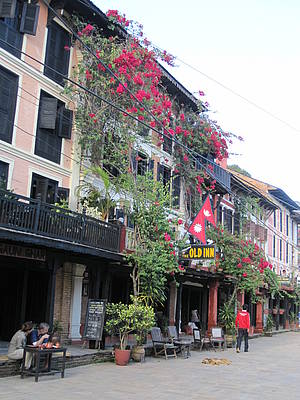
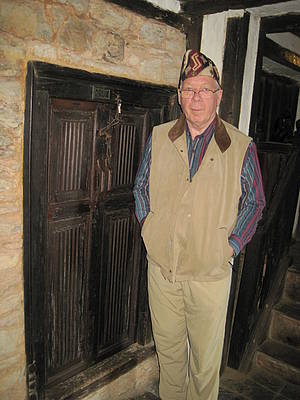
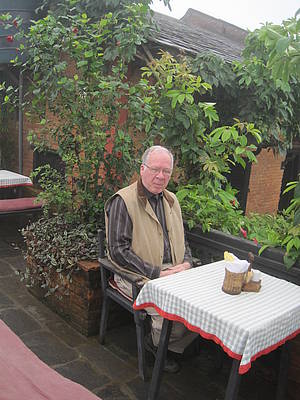
The lodge Old Inn was built on the principles of traditional Nepalese architecture. In the past, houses were built originally from the timber, later from the red bricks without plastering. There was a space for animals, toilet and storage on the ground floor – in most cases this space is now changed into a little shop, especially in tourist centers. The first floor had a living space, and second floor contained bedrooms and kitchen. The doors were all quite low from two reasons: the Nepalese were (and are) smaller than Europeans, but the main reason was that it was a custom to greet by a bow when entering the house, already at the threshold. So it did not matter that the door was low. However, we had to admire the beautifully carved doors and windows, some of them real masterpieces.
16th October
We started our 2 hours trip to Pokhara along the Seti river and were accommodated in the Fulbari Resort. The driver could not find this place as it was situated a little bit separated at the outskirts in the middle of beautiful gardens and gorge with a small river with milky water (calcium). Another reason why he got lost was that many streets in the centre were closed because of Gurgha Festival - called 100 Years jubilee. In the evening we were taken to a view point to observe the sunset and Himalayas, all the beautiful mountains in Annapurna range (Annapurna means Goddess of the Harvest). We were lucky and could see them appearing out of the clouds from our hill which was around 1800 meters high. This section of Himalayas includes 8091 high Annapurna I, 13 additional peaks over 7000 m and 16 more ofer 6000 meters. It is 55 km long. The most visually attractive mountain is Fish Tail or Machha Puchhre. This mountain cannot be conquered, as it is considered to be sacred by Hindus – the locals are bonding it with Lord Shiva. Especially from the rear side it looks like fish tail – from the front more as a triangle, but it is really the most spectacular mountain from the Annapurna range.
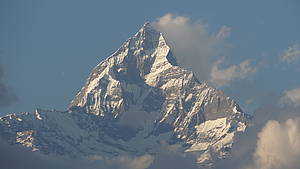
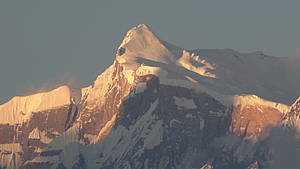
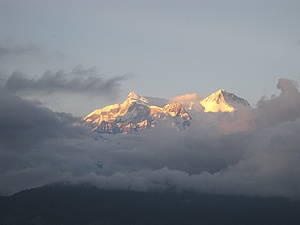

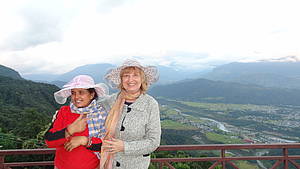
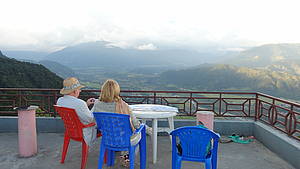
17th October
The sightseeing tour through Pokhara. Again, we had again a very good, well educated guide (he studied anthropology and history, spoke fluent English, had his own ideas, and was serving as a guide not only for sightseeing but also for trekking, paragliding, mountaineering etc. – for each of these activities he had to acquire a special license). He said that he came from the hills, his parents were still living there and always worked very hard – his father earned some money by going to work in India and when he returned and built a house he was envied by other villagers. The Nepalese economy is based mainly on the agriculture and contributions which individual members of the family transfer home whilst employed mostly in the Gulf region (better paid) or India. Tourism is the second leg of economy, but it is very unreliable. At the time of our stay, there was a tragedy in the Annapurna range – the unexpected rains and snow strangled many trekkers, 29 of them lost their lives and many were still missing. Tourists started to cancel their reservations. Our guide also lost his next customers from Switzerland for whom he prepared a 14 days trekking tour including equipment etc. He said that the streets of Pokhara looked empty - many tourists cancelled their booking. Such tragedies could be also a severe blow to local population and their fight for economic survival.
The driver came from the mountains (they make a difference between the hills and mountains). The life in the mountains is obviously still harder than in the hills, his family was really poor. The driver wanted to go to the army, which seems to be a dream job of boys from poor families, but somehow could not make it, so he became a driver and was now happy about it. When we went to the sun set spot in the evening, we could see young boys carrying heavy burdens in carrycots on their backs as physical training in preparation for exams to be accepted into into the army. The same carrycots are also used by women for carrying grass for feeding animals or by men for carrying the wood – you could hardly see the people behind the load.
First point of our visit in Pokhara was a temple where the practice of animal sacrifices to the goddess Durga is still alive – fortunately not everybody is doing it, some worshipers simply bring fruits and flowers, so we did not need to watch the slaughter – however, the stairs to the temple were stained by fresh blood of animals which were sacrificed before (this ritual is forbidden in India).
Then we had a rowing ride on the lake Phewa (the third biggest in Nepal) to a small island with a tiny and for Hindus very important temple.
The next stop was to a Tibetan Refugee Centre. They celebrated the 50th anniversary of founding their colony – they fled from Tibet and were given by Nepalese government Accommodation in small houses where they can practice their customs and religion – they still hope that they will be able to come back to their home country, independent Tibet.
Our guide was not big friend of Indians, he thought that as tourists they behaved noisily and showed superiority to the Nepalese, because they believed that their country, although also not much developed, was superior to Nepal. The economic relations of both countries are very tight, the Indians do not need visa for Nepal and visa versa (for us it was an easy procedure on arrival at the airport). Our guide was also of the opinion that population of Pokhara should be grateful to hippies who discovered this town in the sixties, because the town of that time enabled a simple cheap life and enough of cheap marihuana. He said that Pokhara would not become known in the world at all if it were not for them, no tourists would have ever discovered it – nowadays it is on the agenda of nearly every tourist who visits Nepal.
The last stop was at so called Devi´s waterfalls. According to locals the name is a corruption of David´s Falls reminding two Swiss tourists who tumbled into the sinkhole and drowned (his name was David).
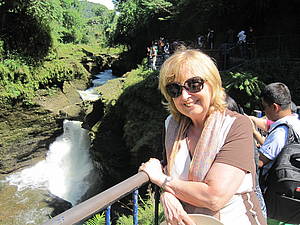
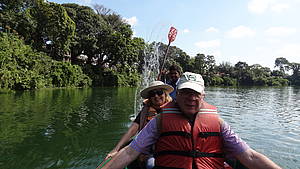
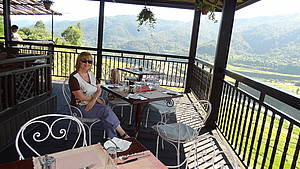
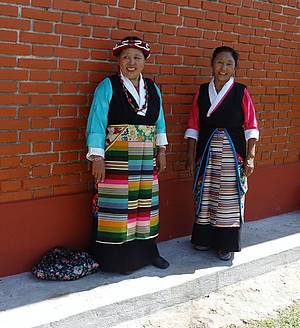
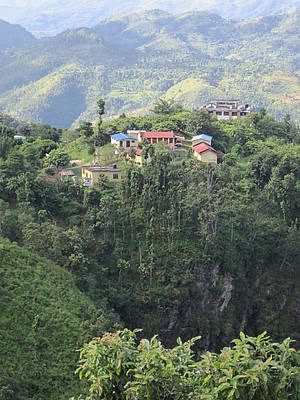

18th October
After breakfast we left for Royal Chitwan National Park near the southern border with India. It is the first and suposedly the best protected area in Nepal.
The journey took 5 hours. After reaching Machan Villa Lodge and late lunch we had a fantastic experience of safari on the back of elephant going through the jungle and encountering rhinos. We saw at least five, couples, mother with a baby etc. The elephants can get everywhere in the jungle, there is nothing to stop them – up and down the hill through the thickness of the forest, slowly walking and not afraid, with us on the back as if we were light as feathers. The Asian Rhinos have only one horn and looked like panzer machines – they did not seem to be disturbed, they just walked away in a distinguished way.
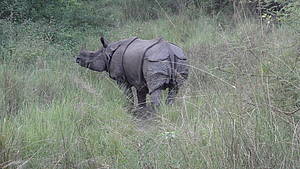
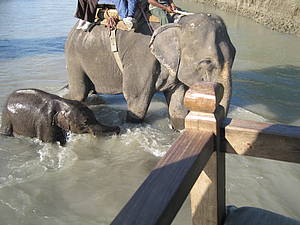
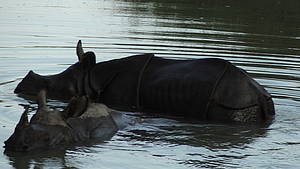
In the evening we attended a dancing performance of young men and vwomen from local village. The dances were similar to Indian Dusseira dancing with the sticks and the show was much more authentic than the tourist trap in Kathmandu.
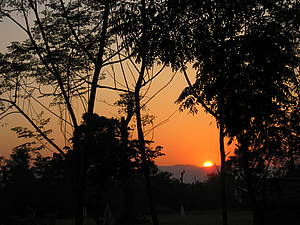
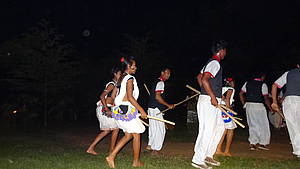
19th October
In the early morning we went on the next safari, this time by a jeep. However, what is possible for an elephant, might not be possible for a jeep. Already after about an hour we got stuck in the mud on the road in the middle of the tropical forest. After many attempts to get out which were not successful (the wheels were only getting deeper and also pushing did not help), the ranger called the camp for assistance (thanks god for mobile phones). In between a tractor reached this critical place and blocked from one side the access to our jeep completely. The tractor driver could have tried to get us out, but he did not have a rope (neither had we). Finally the help arrived with shovels and hacks and managed to remove the mud around the jeep so that we could continue. On the way we only saw some birds and deer and then we reached banks of the wide river. Rowing on this river was very nice, however the ranger tried to find some crocodiles. There were supposed to be many of them (also as per all brochures) but we could not see a single one. I guess that they must have disappeared when they heard I was on approach. 
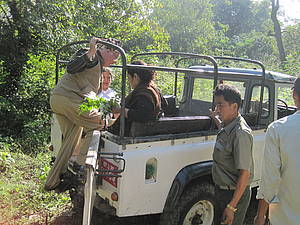

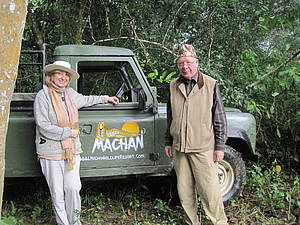
In the afternoon we went for feeding elephants which included a special lecture about the Asian elephants which differ from the African ones.
Elephant story.
Her name is Káli. She does not have tusks, only females of African elephant have them. Her baby which followed us during safari was only 14 months old, they are sucking mother milk till 4 – 6 years of age. The elephants achieve an average age of between 70 – 80 years. The nature reserve workers are not very much enchanted when the female elephant gets pregnant (in difference to the zoo, which are over the moon when it happens). The reason is money – when the elephant gets pregnant she refuses to work and it takes 22 – 24 months before the calf is born. And in between she has to be fed. Any elephant consums daily 350 kg food!! Grass, rice, twigs, fruits etc. They are really eating uninterruptedly – also when we went on safari, she was biting off grass and twigs whenever the occasion arose. The pregnancy of Kali was a coincidence – the elephants from the reserve were grazing on the border of reserve and a herd of wild elephants approached them – one wild male fell in love with Kali – and the result was a baby.
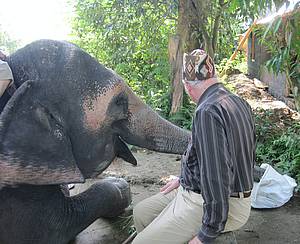
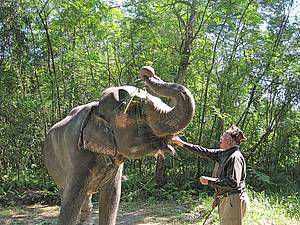
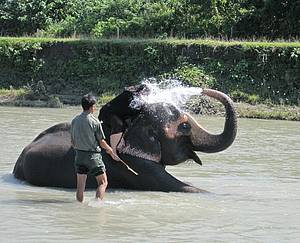
Later we were taken to the river to observe bathing of elephants. If we wanted we could let ourselves to be showered by the elephant trunk or to bath with them but we did not have the swimming suit J and were not sure if the tropical river, although in the mountains, does not represent a health risk.
Architecture again:
I mentioned before, in Kathmandu, most of the buildings were constructed from red bricks. In Chitwan there was more of Indian (or even Goan style) – plastered and colourfully painted houses. Wealthier people try to have the entry on the first floor balcony decorated as i fit were an entry to a palace or temple – two columns with column heads ornated in gold.
Stories about people we met in Chitwan
(I have always been interested not only in the monuments and nature, but also in people, local ones and travelers as well)
Finnish family, father, three daughters and one son, tried to enter two times the same river J and organized so called „Nepal revisited“ trip. Father used to work in a small Nepalese village as a part of development program of Finnish government 34 years ago – at that time with his wife and with the eldest girl who was one and a half year old. Two of the other kids were born in Nepal. There was no water supply in the village which was situated 4 hours walking from the main road. Mother of the family decided not to join the excursion. She said that she was not so advanterous any more and she probably had enough of Nepal (that´s what her daughter said to me). The family visited the village where they spent some years of their lives and was surprised about the progress - the new road made it possible to reach the village by jeep (no more four hours walking) and there was also a new well for drinking water.
The time is flying – and the situation changed. Presently the father works as a manager of University of Helsinki. The oldest daughter combined studies of environment and economy – she is convinced one cannot exist without the other. The second daughter studied aircraft engineering and works in cargo logistics at the moment, as there are nearly no jobs available in her field (she would be able to diagnose technical faults of the planes and repair them). The youngest daughter is a legal assistant (the only one who married and lives in Switzerland). The only brother supplies school canteens with lunches (and is responsible, that they should be healthy, tasteful, and cheap – as per his words, the last on eis the most difficult one). They were all nice people and it was an enrichment to be able to talk to them in the evening.
When we got stuck in the mud we shared this adventure with two Nepalese, mother and daughter. Mother had been living in the USA for 15 years. She had a small franchise business (fresh yogurt sale) in Atlanta, but disliked the city, sold the shop and had just moved to New Orleans, where she works as a taxi driver and is completely happy. She has a green card, but she did not become US citizen because she would have to give up her Nepalese nationality (no double citizenship allowed for Nepalese). From that reason it has not been so easy for her daughter to get to the U.S. after she became adult. However, daughter is now married in Kathmandu, has her own daughter, who already studies in the U.S. as well, so everything seems to be fine. I always have to admire the flexibility of the people, especially women from third world countries. This lady moved to the U.S., making her living in an unknown country quite successfully. Her only sister lives and works in Canada. They have four brothers but they all remained in Nepal. Now both the sisters have organized this „get together“ in Nepal and will spend some time with their mother, who is already 85.
20th October
Departure from Machan Villa Lodge to Kathmandu – 6 hours journey.
21st October
Both of us got a flu and running nose, George was hit more, so I went for sightseeing with Dirk India Pozzocrete distributor in Katmandu Ritesh on my own. First we visited the main Kathmandu stupa on the hill Swayambhu, with a beautiful view around all valley and at the town. I purchased some buddhist souvenirs in one of the shops situated around Swayambhu Stupa and enjoyed haggling about the price. Ritesh gave us as a present a nice statue of Manjushri. Then, to complete our tour in the Valley, I was taken to the historical part of the third valley city Patan (the others are Kathmandu and Bhaktapur - each of them had its own king in the times of Malla kings), followed by a walk in the narrow lanes of Patan. I also visited Ritesh´s office (he is envolved in construction consulting and has about 40 employees) and later on was taken to their family restaurant for a typical Newar meal (Ritesh and his family are Newars).
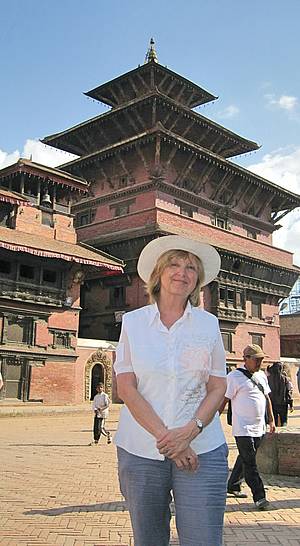
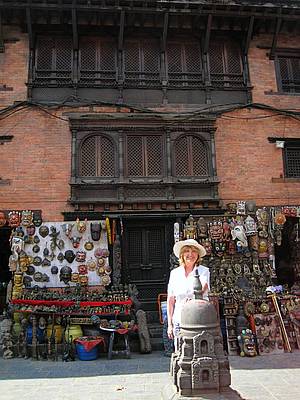
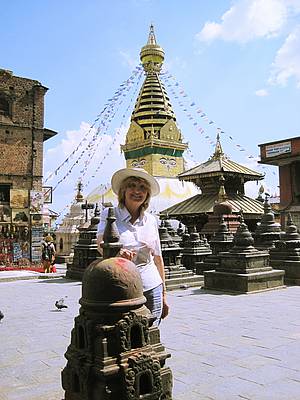
Typical Newar food: spicy soup made from all type of beans; boiled potatoes cut into small peaces and covered by special red/orange spices (not curry, not chilli) as a starter. Rice cake (rice mash, eggs etc. fried in a thin layer as omelete), round shape, cut into slices as pizza – they also call it Nepalese pizza. Nepalese are mostly not vegetaraians, so the next course were small pieces of chicken, nicely seasoned. One of the specialities served was also yak cheese.
In the evening we invited Ritesh with his wife Sweta for dinner. George could already participate as well.
22nd October
Departure from Kathmandu to Mumbai. This time the luggage was not checked through as on the arrival trip, we had to collect the suitcases at the international terminal, check them in again and then go by bus from international to domestic. Inbetween there were at least five security controls (the same in Kathmandu on departure) and another six checks if the stamps given on the boarding card and luggage tags were really there. We really hate these procedures, which do not increase the safety at all as they are just formality but nothing can be done about it.
One more quotation from the garden of meditation of hill resort Dwarika: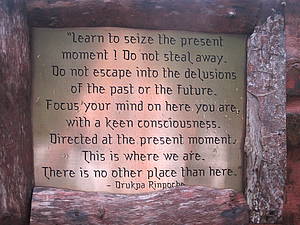
Summary
All holiday was amazing. Highlights: meditation lecture, view of Himalaya mountains, safari on the elephant back, walks in the centre of three historical cities of Kathmandu Valley – Kathmandu, Bhaktipur, Patan.
GODS, PEOPLE, NATURE